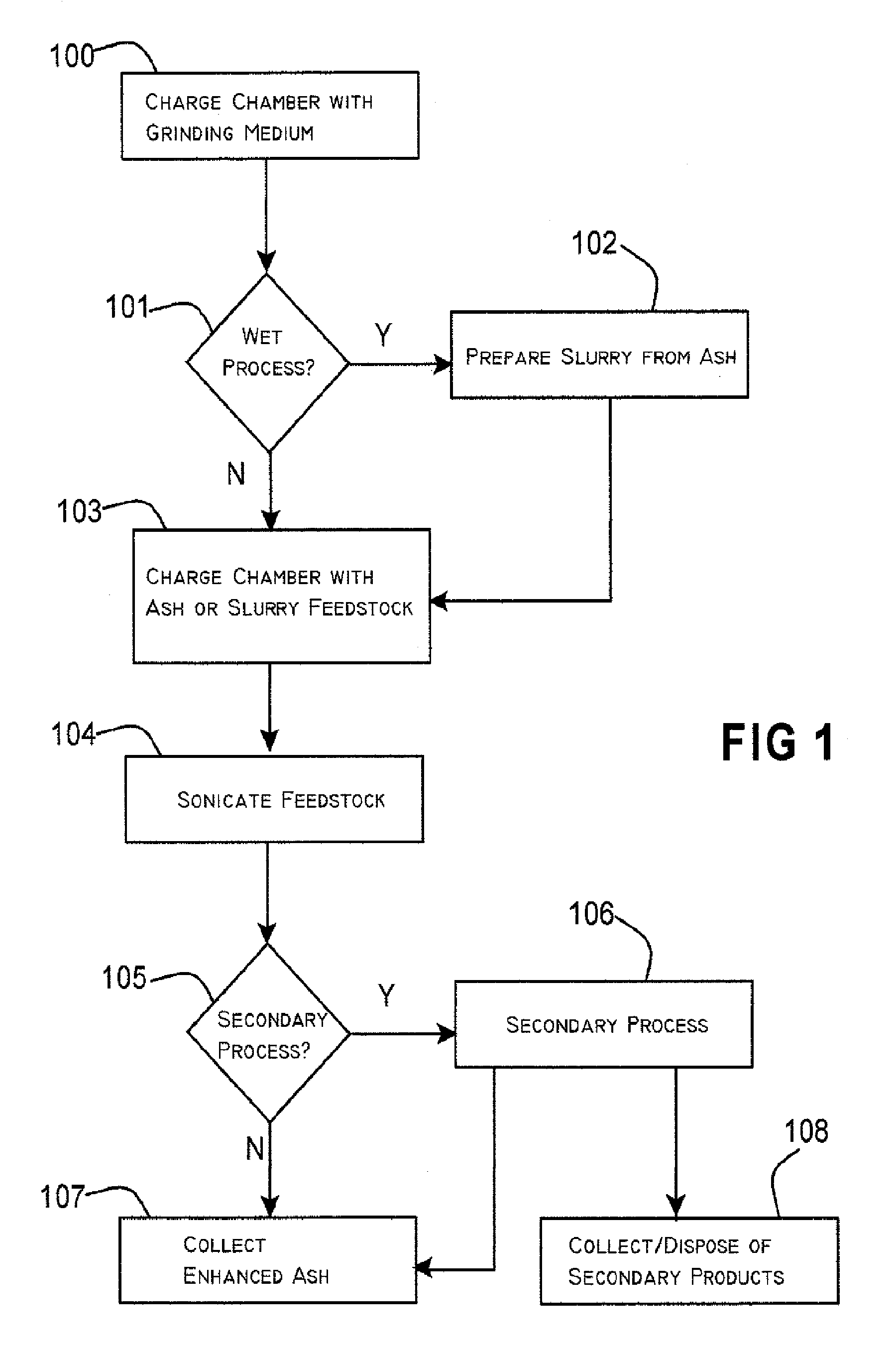Upgraded combustion ash and its method of production
a technology of combustion ash and combustion ash, which is applied in the field of combustion ash, can solve the problems of high ammonia content in cementitious materials and pozzolans, affecting the application of blended cement and concrete, and the value of bituminous coal fly ash as pozzolan is limited, so as to enhance the numerous qualities of ash, quick and cost-effective
- Summary
- Abstract
- Description
- Claims
- Application Information
AI Technical Summary
Benefits of technology
Problems solved by technology
Method used
Image
Examples
example 1
Comparison of Media Diameter and Ash Particle Size with Respect to Prior Art Methods
[0039]Table compares grinding media use in acoustic frequency sonicators of the Nyberg type. Macas ground sodium metal and Anthony ground fluidized bed combustion ash to reduce its lime content prior to disposal. These data clearly show that as the grinding media diameter decreases and TMV / CV ratio increases, processed ash quality (i.e. surface area) improves even for low grinding times, especially in the presence of water. TMV / CV ratios are higher and grinding media diameters in the current invention are lower than those demonstrated in the prior art. The sonication chamber volume CV was 3 litres for the current invention data in Table Sonication was carried out at 30 kilowatts input power for one sonication chamber.
TABLE 1GrindingmediaAshDiameterTimeAshWaterTMVSurface AreaGrinding Media(mm)(min)(litres)*(litres)(litres)TMV / CV(m2 / g)Anthony 20049.530.500.17Anthony 20089.535-400.400.20Macas 19946.530....
example 2
Dry Pulverization of Subbituminous Coal Fly Ash to Enhance Particle Size Distribution and Surface Area
[0040]Table 2 compares subbituminous coal fly ash quality after sonication for 1 minute at 90 to 120 Hz frequency, in a baffled (3 baffles) 3.2 litre sonication chamber at 20-25 kilowatts input power using 1.18 mm steel shot grinding media without water addition. The bulk grinding media volume and bulk ash volume were approximately 60% and 40% respectively of the sonication chamber volume.
TABLE 2% Improvement DryRawDryPulverization vs. RawAshPulverizedSubbituminous AshD10 μm0.90.650D50 μm9.38.410D90 μm45.937.419Specific Surface3.233.9322Area (m2 / g)
[0041]The D10, D50 and D90 values in the above table refer to 10, 50 and 90 weight % portions of the sample having a mean diameter below the stated values e.g. 0.9, 9.3 and 45.9 micrometres respectively for the raw ash. This example shows the ability of the current invention to produce cementitious fly ash with decreased particle size, imp...
example 3
Dry Pulverization of Bituminous Coal Fly Ash to Enhance Particle Size Distribution and Surface Area
[0042]Table 3 compares bituminous coal fly ash quality after sonication for 1 minute at 90 to 120 Hz frequency, in a baffled (3 baffles) 3 litre sonication chamber at 20-25 kilowatts input power using 1.18 mm steel shot grinding media without water addition. The bulk grinding media volume and bulk ash volume were approximately 60% and 40% respectively of the sonication chamber volume.
TABLE 3% Improvement DryRawDryPulverization vs. RawAshPulverizedBituminous AshD10 μm7.55.921D50 μm36.513.463D90 μm99.131.368Specific Surface0.561.31234Area (m2 / g)
[0043]This example shows the ability of the current invention to produce bituminous fly ash with enhanced particle size distribution and surface area via dry pulverization.
PUM
| Property | Measurement | Unit |
|---|---|---|
| diameter | aaaaa | aaaaa |
| particle sizes | aaaaa | aaaaa |
| median size | aaaaa | aaaaa |
Abstract
Description
Claims
Application Information
 Login to View More
Login to View More - R&D
- Intellectual Property
- Life Sciences
- Materials
- Tech Scout
- Unparalleled Data Quality
- Higher Quality Content
- 60% Fewer Hallucinations
Browse by: Latest US Patents, China's latest patents, Technical Efficacy Thesaurus, Application Domain, Technology Topic, Popular Technical Reports.
© 2025 PatSnap. All rights reserved.Legal|Privacy policy|Modern Slavery Act Transparency Statement|Sitemap|About US| Contact US: help@patsnap.com


